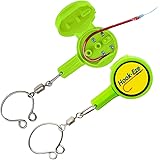Welcome to the world of bass fishing! Whether you’re a beginner or an experienced angler, there’s always something new to learn when it comes to catching these elusive creatures. In this article, we’ll cover everything you need to know about bass fishing for beginners, from choosing the right gear to understanding water conditions and weather patterns. Let’s get started!

1. Introduction to Bass Fishing:
Bass fishing is one of the most popular types of fishing in the United States. It involves targeting several species of black-and-white striped fish that are known for their strength and aggressiveness. These fish can be found in freshwater lakes, rivers, and ponds across North America. While some people enjoy eating bass, many others simply love the thrill of the fight and the challenge of landing such a powerful creature.
2. Choosing the Right Gear for Beginners:
When it comes to bass fishing, having the right equipment is essential. As a beginner, you don’t want to invest too much money into expensive gear until you’ve mastered the basics. Here are some tips on what to look for:
Rod: Look for a medium-light rod with a fast action. This will allow you to cast light lures and feel even the slightest bite.
Reel: A spinning reel is ideal for bass fishing because it allows you to easily cast and retrieve your line. Look for one with a smooth drag system and enough capacity to hold at least 100 yards of line.
Line: Braided line is great for bass fishing because it has no stretch and provides excellent sensitivity. You can also use monofilament line if you prefer.
Lures: Start with basic baits like plastic worms, crankbaits, and spinnerbaits. These are easy to use and effective for catching bass.
3. Finding the Best Spots to Catch Bass:
Once you have your gear ready, it’s time to find the best spots to catch bass. There are several factors to consider when selecting a location, including water depth, structure, vegetation, and temperature. Some general rules of thumb include looking for areas where the bottom drops off quickly, searching for underwater structures like rocks, logs, and docks, and finding places where there is plenty of shade and cover. Additionally, pay attention to the weather patterns and how they affect the behavior of the fish. For example, during hot summer months, bass may seek out deeper waters to escape the heat.
4. Understanding Water Conditions and Weather Patterns:
As a bass fisherman, it’s important to understand how different water conditions and weather patterns can impact the behavior of the fish. For example, low water levels can make it more difficult for bass to hide and ambush prey, while high water levels can spread them out and make them harder to locate. Similarly, changes in barometric pressure can cause bass to become less active or move to different locations. By keeping track of these variables, you can adjust your tactics accordingly and increase your chances of success.
5. Tips on How to Hook, Fight, and Land a Bass:
Finally, let’s talk about how to hook, fight, and land a bass once you’ve located one. When you feel a bite, set the hook firmly but not too hard – remember, these fish are strong and can easily break your line. Once you’ve gotten a good hookset, let the fish run a little bit before starting to reel it in. Keep constant tension on the line and try to steer the fish towards shallower water where you can see it better. Finally, when you’re ready to bring the fish in, use a net to avoid damaging its fins or scales. And don’t forget to take a few photos before releasing it back into the water!
In conclusion, bass fishing can be a challenging but rewarding sport for both novice and expert anglers alike. With the right gear, knowledge of water conditions and weather patterns, and a willingness to adapt your techniques, you can start catching bass in no time. Happy fishing!































































